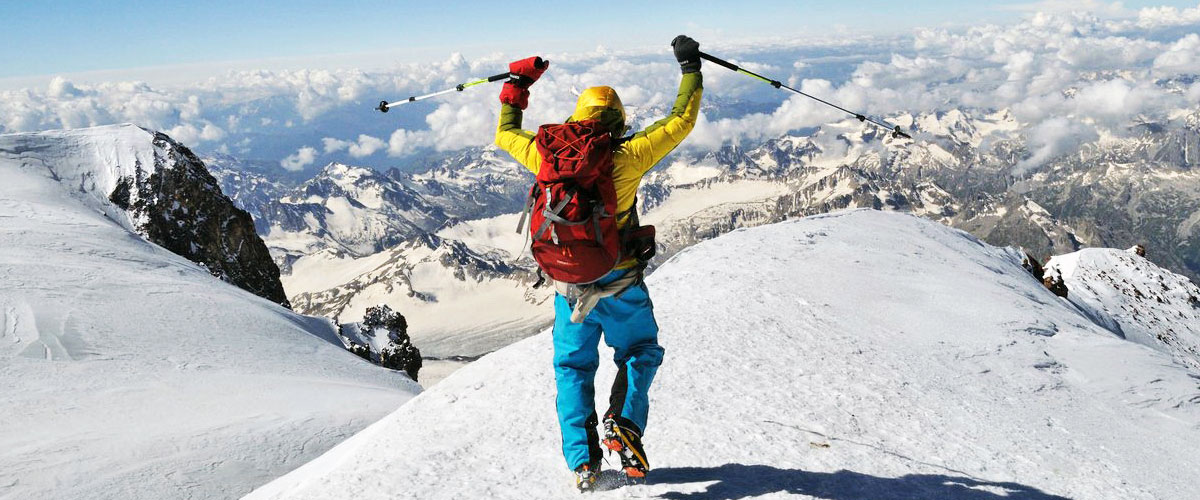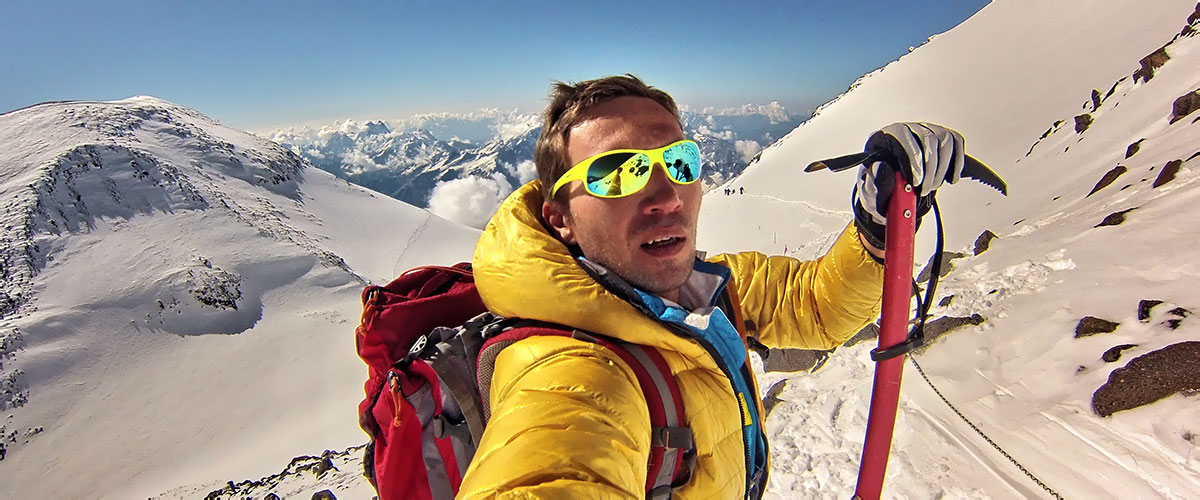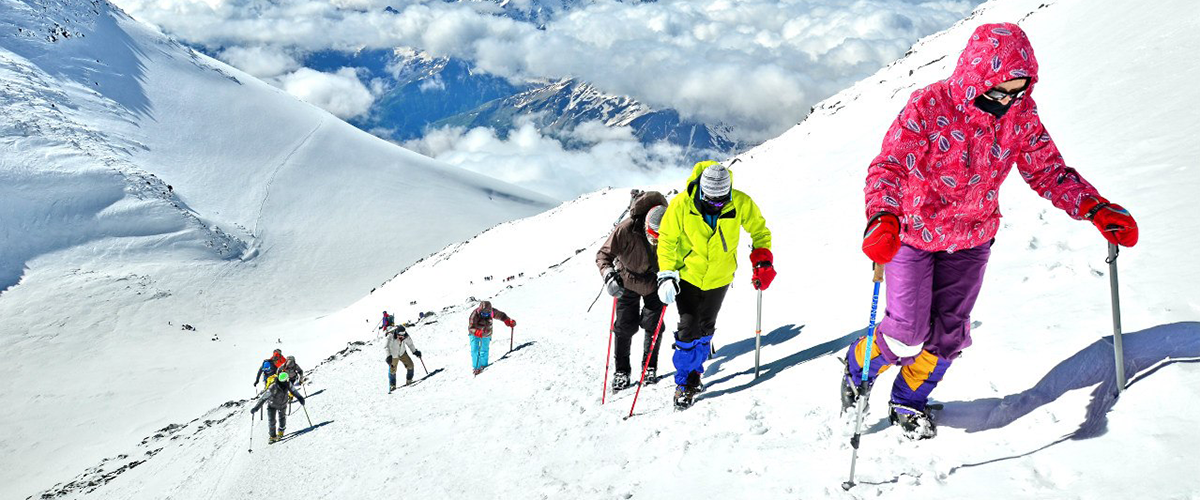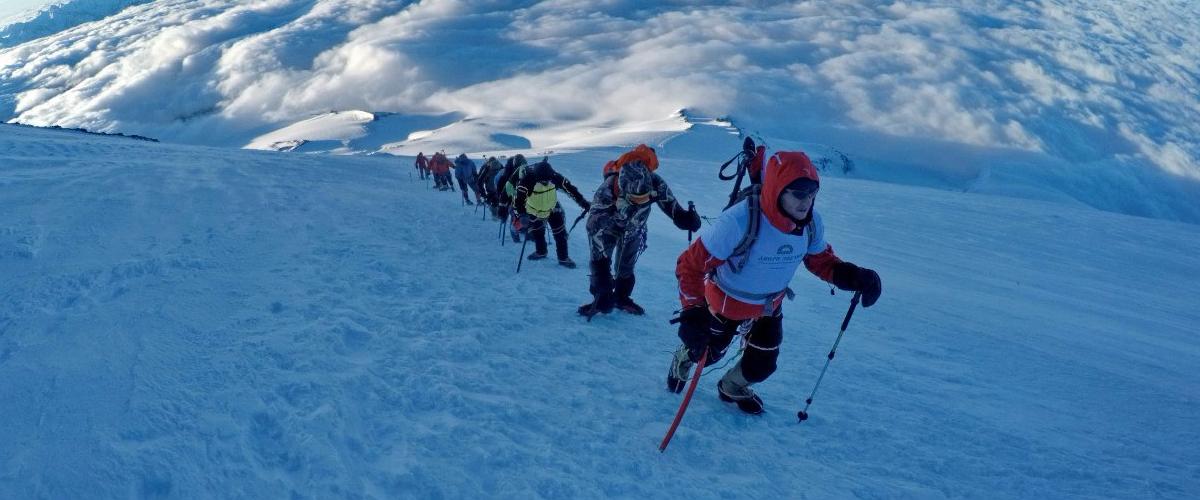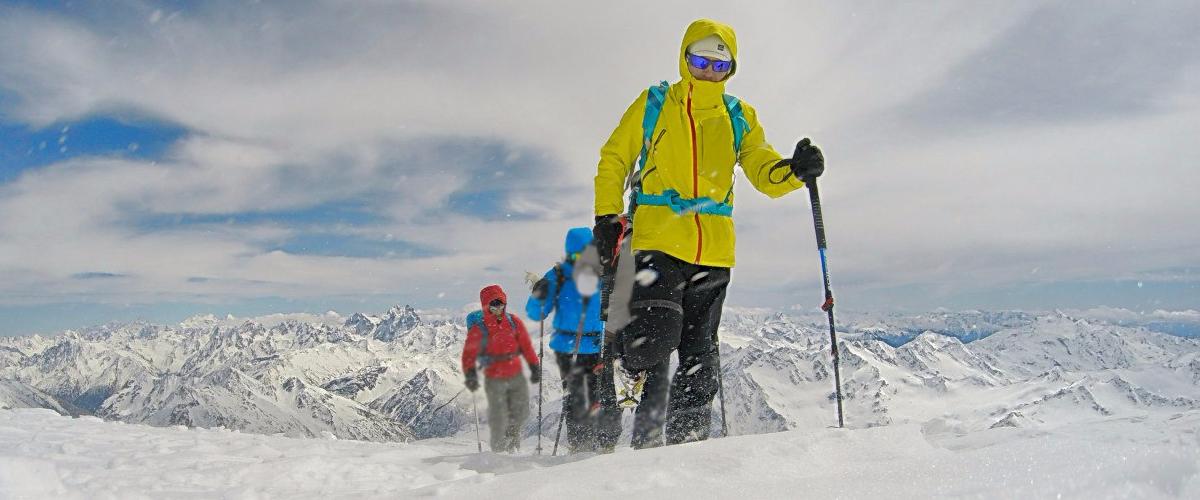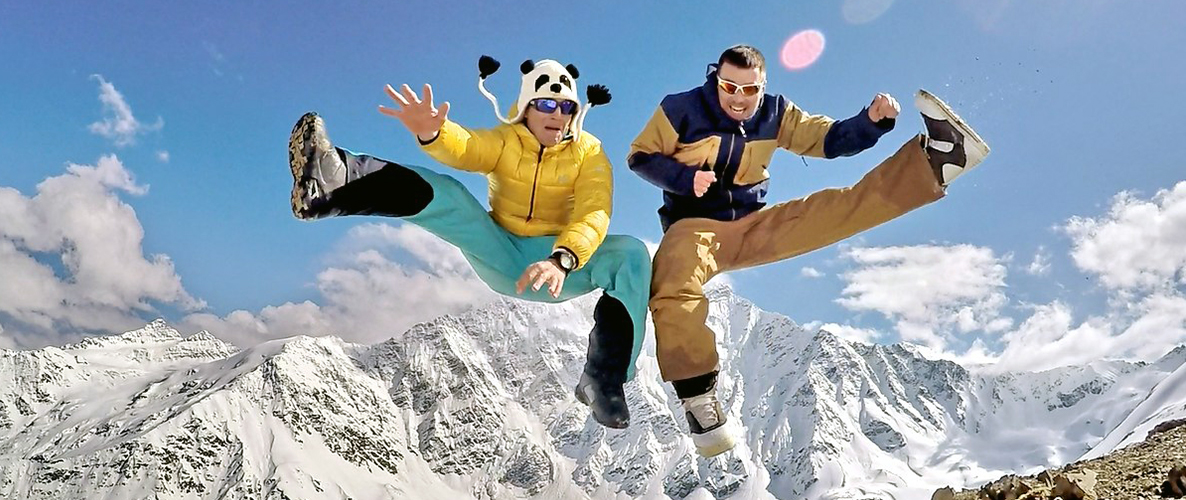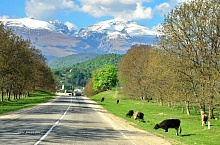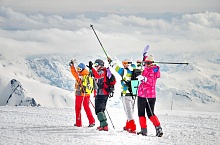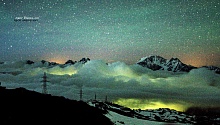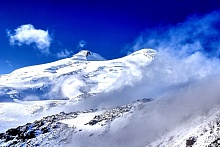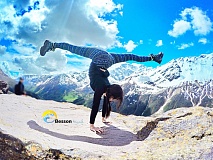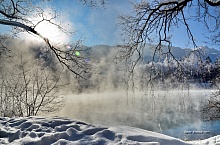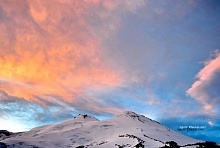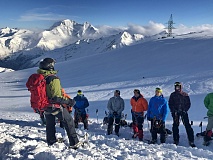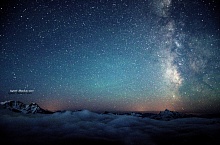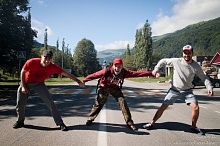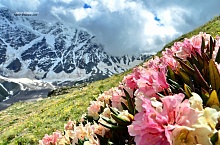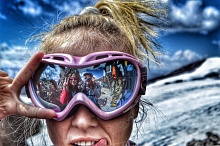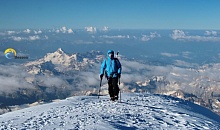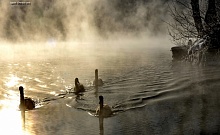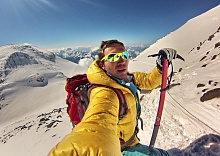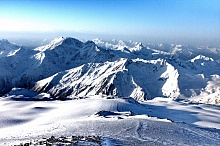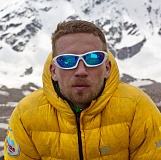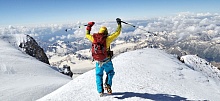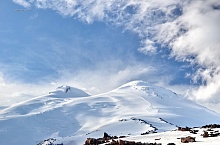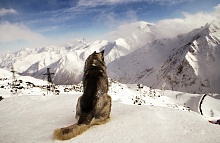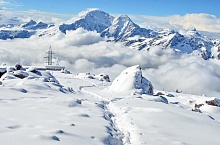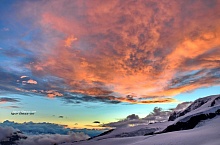TEST BY HEIGHT
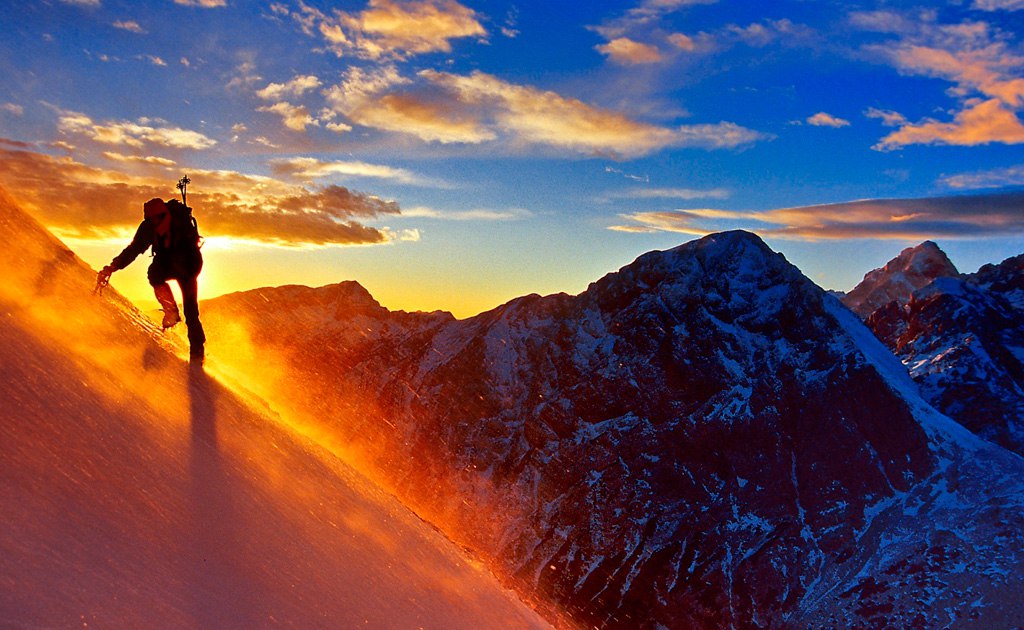
Weather conditions and the state of the route are the two main problems that concern the experienced climbers on Elbrus. Climbing in bad weather or with a poor forecast is better not to start. The main number of deaths on the slopes of the mountain are those who simply lost the right path in the absence of visibility. The presence or absence of bare ice on the route determines its technical complexity. In good conditions sometimes you can stay without crampons. Even the experienced climbers start to worry in winter or more often in spring time when the area of "bottle" ice appears. Insurance organizing on a long stretch seems too long. Therefore they go very, very carefully, but without insurance. One wrong move and .... Fly to the end of the slope. Luckily, ice almost never happens in the summer.
If you are lucky with these two points than climbing Elbrus can be quite easy for you. But no matter how lucky you are, you will get one problem for sure. It is the reaction of your body to changes in external conditions: the altitude, solar radiation, coldness and other unfavorable factors. It becomes a test of the height experience for climbers.
Since ancient times scientists and mountaineers knew the phenomenon of decreasing the working possibilities of the body in the mountains. There is a fast decrease of cardiovascular activity, respiratory, digestive and nervous systems, especially in the first days of stay at altitude. In many cases it led to the acute mountain sickness, when there appeared a direct threat to human life. The higher the height, the worse the state of health. At the same time, the local people who accompanied the climbers reacted even more calmly to the change in climatic factors. On the one hand it can be the individual character of the reaction to height. On the other hand it led to conclusions about the possibility of adapting to unfavorable factors.
Climber needs a prior acclimatization, carried out in a proper sequence. Usually it involves a gradual climb with a descent to a lower height for the night. Theoretically, we recommend to climb Elbrus after no less than 7-10 days of active walking at lower altitudes. But in practice people often go climbing on 4th or 5th day after coming to the mountains. This is our behavior which is determined by social conditions. The time is never enough. This is a modern way of life.
Here is what science says about the unfavorable factors of the highlands.
1. Temperature. With increasing altitude, the average annual air temperature gradually decreases by 0.5 ° C for every 100 m. In different seasons and in different geographic regions it decreases unevenly. In winter it is slower than in summer, making 0.4 ° C and 0, respectively, 6 ° C. The average temperature decrease in summer is 6.3-6.8 ° per 1 vertical kilometer in the Caucasus. But in practice it can be up to 10 degrees.
2. Humidity of air. Humidity is the amount of water vapor in the air. Since the pressure of saturated water vapor is determined only by the air temperature, in the mountain regions where the temperature is lower, the partial pressure of water vapor is also small. Already at an altitude of 2000 m, air humidity is half that at sea level, and at high mountain altitudes, air becomes almost "dry". This circumstance increases the loss of fluid by the body not only by evaporation from the surface of the skin, but also through the lungs during hyperventilation. Hence the importance of ensuring an adequate drinking regime in the mountains, because dehydration of the body reduces efficiency.
3. Solar radiation. At mountain altitudes, the stress of the radiant energy of the sun greatly increases due to the great dryness and transparency of the atmosphere and its lesser density. When climbing to an altitude of 3000 m, the total solar radiation increases by an average of 10% per 1000 m. The greatest changes are detected by ultraviolet radiation: its intensity increases by an average of 3-4% for every 100 m of elevation to the altitude. The body is affected by both visible (light) and invisible (infrared and most biologically active ultraviolet) solar rays. In moderate doses, this can be beneficial to the body. However, excessive sun exposure can lead to burns, sunstroke, cardiovascular and nervous disorders, exacerbation of chronic inflammatory processes. With recruitment, the increased biological efficacy of ultraviolet radiation can cause skin erythema, keratitis (inflammation of the cornea of the eyes). Creams, masks, goggles are mandatory items for climbers on Mount Elbrus. Although there are people who easily stays without it.
4. Atmospheric pressure. As the atmospheric pressure increases, whereas the oxygen concentration, as well as the percentage of other gases, remain constant within the atmosphere. In comparison with sea level, the atmospheric pressure at an altitude of 3000 m is lower by 31% and at an altitude of 4000 m - by 39%, at the same heights it increases from high latitudes to low and in a warm period it is usually higher than in a cold. The fall in atmospheric pressure is closely related to the main cause of mountain sickness, a lack of oxygen. Its called lowering the partial pressure of oxygen. The results of the experiments show that at an altitude of 3000 m, the amount of O2 decreases in the inhaled air by one third and at an altitude of 4000 m twice. All this leads to a lack of oxygen saturation in hemoglobin, the tissue receives its insufficient quantity and a phenomenon called hypoxia. This is actually the reaction of the body to this phenomenon.
Preparation for the ascent. Training. Sometimes you can hear stories about the fact that a person does not train and walks calmly to high altitudes better than prepared athletes. Well, legends can have a place in communications. Anyway we are not welcome for unhealthy way of life without trainings. First of all you should improve stamina for a successful ascent to Elbrus. Also readiness of the heart, lungs and muscles for long-term work. Skiing and running for long distances are the best trainers. On the other hand, we should pay attention to the opposite point. Athletes who are in peak form are often very vulnerable to infectious diseases. Therefore, good trained people should reduce the load about a week before going to the mountains. And to avoid competitions a week before. In addition, the body must accumulate a store of fat.
Stuff preparation. Equipment. Many people easily relate to all kinds of fees, even try to boast of their sloppiness. Mountaineering should make such people more organized. Here, each taken or not taken object can cost a life, not only to you, but also to your friends on the ascent. You must always make a careful preparation and selection of equipment. Make a list and work out each item in advance, including medicines. Do not hesitate to contact the organizers with questions on the selection of equipment and medical support for the climbing.
Meals during preparation. We recommend to prepare yourself the way athletes prepare for a responsible start. The last week before the climbing you should eat a lot of healthy food, combined with carbohydrates. A course of taking vitamin complexes is recommend. This should be a multivitamin complex. Take them strictly according to the doses following the instruction. Or better ask a personal doctor.
The acclimatization period In the mountains. First days. Do not worry. A normal healthy organism should demonstrate its response to changed conditions. Do not panic if immediately upon arrival in the mountains you will feel unwell, dizzy, lack of appetite, etc. Each person's reaction is unique. In theory, the body must make the right conclusions. First of all avoid medications, let the headache be. Let the nausea pass by itself. It is not recommended to overeat and drink alcoholic beverages during acclimatization. Leave it on the final part of the expedition. It is necessary to continue the course of taking multivitamins, started before. The body needs it before the expedition.
Meals during the acclimatization period.
During this period, in conditions of changing the work of the body, there may be disruptions in appetite. Do not eat anything by force. Eat what you want. It is desirable to eat a lot, varied and natural food. However, it should be remembered that the basis of the diet under hypoxic conditions should be carbohydrates. The most easily digestible carbohydrate is sugar. In addition, it positively affects the protein and fat metabolism that varies in high-mountain conditions. The daily requirement for sugar when climbing increases to 200-250 g. Each ascender to the altitude is more consumed by ascorbic acid with glucose. It is desirable that on all outlets in the jars there was tea with sugar and lemon or ascorbic acid.
Immediately before the ascent sleeping mode on 3500 - 4200 meters turns into torture. It is advisable to get a good sleep during the day before climbing. It is recommended to have a good lunch and also go to bed immediately after lunch. The climb starts in the middle of the night. Before that time you need to feel completely rested. Prepare all equipment in advance. Health protection: glasses, preferably 2 pairs, mask from cold and wind, special protective face cream with protection 30+, lipstick cream SPF 15+, individual medications. There is a person in the group responsible for the public medicine chest. It is the guide-leader. Nevertheless, it is not always comfortable to ask him during the ascension. So, we recommend to have: aspirin, ascorbic acid and lollipops, such as Minton.
Biostimulators. If it is better to avoid medications during acclimatization, then this recommendation of ownership is not so strict on the day of summit. You must be 100% ready that day. Of course, in case of severe headache you should immediately give up climbing. But if the pain is small it should be stopped by pills. We recommend that you have with yourself proven in practice pills to improve performance, which can be conditionally attributed to biostimulators. For example, tinctures of ginseng, eleutherokka, magnolia vine, preparations like pantolex. However, there are no such things that could make the organism's working capacity for a long time. Stronger tablets that increase performance and have a short-term effect should be kept as an NS in the general medicine chest. First of all, train the ability to tolerate and tolerate.
Water regime. Great importance for high-altitude acclimatization, prevention of mountain sickness and preservation of efficiency, has the correct organization of water-drinking regime. Water in the physiological processes of the body plays an important role. It is 65-70% of the body weight (40-50 liters). The human need for water under ordinary conditions is 2.5 liters. At the height you should make it up to 3.5-4.5 liters, which will fully ensure the physiological needs of the organism. Water exchange is closely related to mineral metabolism, especially with the exchange of sodium chloride and potassium chloride. In addition, water-drinking insufficiency is also attached to hypoxia.
Sometimes people talk about the dangers of random water intake during the ascent. However, this can only apply to light mountain trekking, passing the streams. When you can only drink the water on Elbrus that you carry with you, there simply can not be too much. It is necessary to consume liquid in the form of hot tea with sugar and possibly other additives. And to make tea hot you need to have a thermos of the highest quality. Unfortunately, not always expensive thermos can withstand the test by Elbrus. Try it before going to the mountains. According to the drinking regimen drink tea a little more than you want in the morning, before going out. And calculate the volume of the thermos. Make sure you have enough tea for the descent. A tea has a great importance for raising the strength and keeping the attention to dangers in the end of the day.
Acute mountain sickness. It shouldn't happen. This happens on Elbrus mainly with irresponsible people. You need to follow your body and do not hesitate to stop climbing and turn back before the disease enters the acute stage.A guide or leader should closely monitor the condition of all group during the climbing. The appearance of symptoms even a light form of mountain sickness requires an immediate reduction in physical activity and pace of movement. You should start to increase rest periods, and abundant drinking. Taking ascorbic acid (0.1 g) is recommend. It is better to use aspirin for headaches.
With a mountain disease of severe and moderate severity, it is necessary to refuse lifting, urgently and as quickly as possible to reset altitude. This is the most effective medicine. At the same time, if possible, the patient should be deprived of a backpack and heavy clothing. The most important treatment course can be artificial oxygen. However, so far its use on Elbrus is limited to single experiments. Perhaps you should give the patient a diuretic, better dicarb, and in acute cases you can give furosemide. Other protozoan medicines are aspirin, ascorbic acid. Of stimulants, caffeine or better nootropil can be used. Of the new drugs recommended by German researchers as prevention of the caused mountain disease of pulmonary edema, it is Nifedipine and Salmperol (a cure for asthma).
The newest research on mountain sickness. About three years ago the whole world passed a sensational message about the use as a preventive medicine of the famous drug from a little bit of another region - Viagra. It is believed that this miracle cure, blocks some enzymes and dramatically improves peripheral circulation. Including in the lungs. Later it turned out that this message was not limited just to a loud sensation for the press. And Viagra has become part of the funds that many Everest climbers take with them. Moreover, this means of dual use.
Last year, a large medical experiment was conducted on the slopes of the summit of Monterosa in the Alps. 22 mountaineers acted as experimental. The main result was the proof of the practical uselessness of using hormonal drugs based on cortisone as a preventive agent. A popular drug dexamethasone from "Vertical Limit" movie, where climbers carried it in their suitcases was recognized by specialists as "drugs with no sense".
According to the largest expert on medical support for climbing Everest, American professor Peter Hackett, in the coming years, one can expect a breakthrough in studies of mountain sickness. The body response process is determined by such complicated mechanisms as the brain. The medicine will learn in the future how to impact on it. We will allow ourselves a little improvisation on this topic. Indeed, the main thing in mountaineering is in the head and heart. It is the ability to perceive the beauty and greatness of nature and the love of the mountains. If you don't feel it, it is better to give up climbing. And you feel, then there are forces to pass your own ailments.
Author Elkov Alexander


